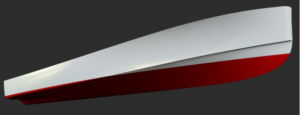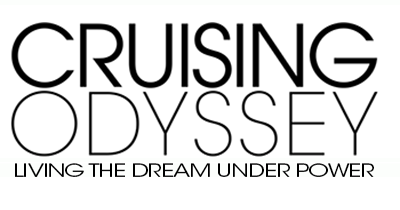
Few names in American boating are more iconic than C. Raymond Hunt. After all, he designed the deep-V hull more than 60 years ago that has been regarded as the gold standard for offshore performance and safety ever since. So it’s news, big news, when his successors have made some adjustments now, creating a more efficient hull shape for today’s yachts with the goal of producing double-digit cruising speeds, under moderate power, while still retaining all the seakeeping abilities of the original.
But Ray Hunt Design, of New Bedford, Massachusetts, has done exactly that, drawing a new Ray Hunt Design High-Efficiency V Hull (see rendering above). And they created a new line of classic American yachts, a new 85 (pictured at top), 96, and 140, all built on that new hull.
The new yachts are traditionally styled, with what the company calls “good proportion of hull to superstructure and free of trendy styling clichés. There are no gimmicks and fads here, just enduring elegance where form follows function in harmony with the sea.”
Winn Willard, the president of Ray Hunt Design, says, “It seemed time to reconsider what a traditional yacht should be, and to offer an alternative to many of the highly styled and retro-styled yachts on the market today, and to work with some of the best American yacht builders.” The new yachts can be constructed in either aluminum or composite materials.
In keeping with the times, the new yachts have lots of open spaces, larger owner’s suites, multiple lounging and dining options, convenient water access, and generous storage for tenders and toys. Owners can choose among many interior arrangements, including popular main-deck owner’s suites.
The new 85 has a fully enclosed walkaround pilothouse and boat deck on top of a deckhouse with the owner’s stateroom forward, and an open galley and salon. The covered aft deck leads to the beach club. The aft engine room isolates noise from the three guest staterooms. A sun lounge is forward. Power comes from twin 800-hp Cats, producing a cruising speed of 16 knots and a top speed of 18 knots.
The 96 and 140 have many of the same design elements, but the 140 flagship is built with “the proportions of a fast, navy cruiser,” the company says. It also will have a cruising speed of 20 knots under moderate power, a considerable accomplishment.
The new hull design recognizes the growing market for yachts operating above displacement speeds, but not completely up into planing speeds. It is a balanced hard-chine V-hull, with some deadrise running the entire length of the boat. It has substantial deadrise forward, narrow waterlines, and a fine entry for low resistance and low-impact accelerations.
The hull is balanced by moderate deadrise aft, distributing displacement evenly along the hull, and moving the centers of buoyancy and effort aft toward amidships (or just aft of amidships), resulting in good directional control.
The full-length deadrise enhances stability, while the full-length hard chine resists rolling. The deadrise also ensures the boat will heel into a turn at speed, with a safer and more comfortable attitude for those on board. A hard chine also means a drier boat.
The new hull incorporates hull tunnels for a lower shaft angle, less draft with larger, more efficient props, and less transom immersion for reduced resistance at displacement speeds. Finally, a hard-chine hull is easier and less expensive to build than a round-bilged hull, and Hunt says “it also does not need the various complicated and expensive add-on appendages.”
See a white paper explaining the new hull design here:
http://ray-hunt-design-new-high-efficiency-v-hull.pdf




